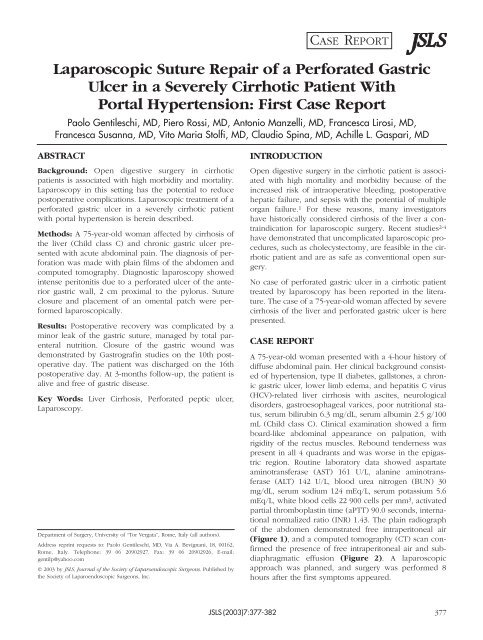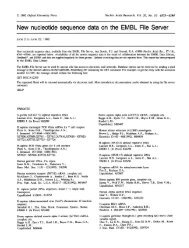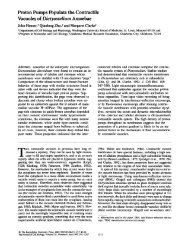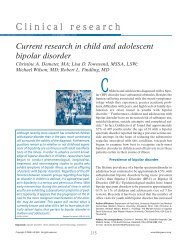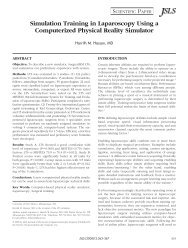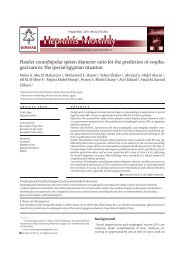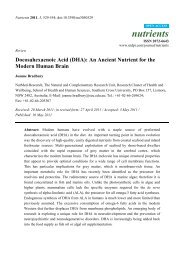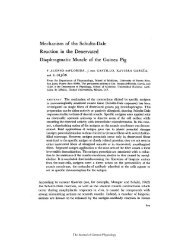Laparoscopic Suture Repair of a Perforated Gastric ... - BioMedSearch
Laparoscopic Suture Repair of a Perforated Gastric ... - BioMedSearch
Laparoscopic Suture Repair of a Perforated Gastric ... - BioMedSearch
Create successful ePaper yourself
Turn your PDF publications into a flip-book with our unique Google optimized e-Paper software.
<strong>Laparoscopic</strong> <strong>Suture</strong> <strong>Repair</strong> <strong>of</strong> a <strong>Perforated</strong> <strong>Gastric</strong><br />
Ulcer in a Severely Cirrhotic Patient With<br />
Portal Hypertension: First Case Report<br />
ABSTRACT<br />
Background: Open digestive surgery in cirrhotic<br />
patients is associated with high morbidity and mortality.<br />
Laparoscopy in this setting has the potential to reduce<br />
postoperative complications. <strong>Laparoscopic</strong> treatment <strong>of</strong> a<br />
perforated gastric ulcer in a severely cirrhotic patient<br />
with portal hypertension is herein described.<br />
Methods: A 75-year-old woman affected by cirrhosis <strong>of</strong><br />
the liver (Child class C) and chronic gastric ulcer presented<br />
with acute abdominal pain. The diagnosis <strong>of</strong> perforation<br />
was made with plain films <strong>of</strong> the abdomen and<br />
computed tomography. Diagnostic laparoscopy showed<br />
intense peritonitis due to a perforated ulcer <strong>of</strong> the anterior<br />
gastric wall, 2 cm proximal to the pylorus. <strong>Suture</strong><br />
closure and placement <strong>of</strong> an omental patch were performed<br />
laparoscopically.<br />
Results: Postoperative recovery was complicated by a<br />
minor leak <strong>of</strong> the gastric suture, managed by total parenteral<br />
nutrition. Closure <strong>of</strong> the gastric wound was<br />
demonstrated by Gastrografin studies on the 10th postoperative<br />
day. The patient was discharged on the 16th<br />
postoperative day. At 3-months follow-up, the patient is<br />
alive and free <strong>of</strong> gastric disease.<br />
Key Words: Liver Cirrhosis, <strong>Perforated</strong> peptic ulcer,<br />
Laparoscopy.<br />
Department <strong>of</strong> Surgery, University <strong>of</strong> “Tor Vergata”, Rome, Italy (all authors).<br />
Address reprint requests to: Paolo Gentileschi, MD, Via A. Bevignani, 18, 00162,<br />
Rome, Italy. Telephone: 39 06 20902927, Fax: 39 06 20902926, E-mail:<br />
gentilp@yahoo.com<br />
© 2003 by JSLS, Journal <strong>of</strong> the Society <strong>of</strong> Laparoendoscopic Surgeons. Published by<br />
the Society <strong>of</strong> Laparoendoscopic Surgeons, Inc.<br />
INTRODUCTION<br />
Open digestive surgery in the cirrhotic patient is associated<br />
with high mortality and morbidity because <strong>of</strong> the<br />
increased risk <strong>of</strong> intraoperative bleeding, postoperative<br />
hepatic failure, and sepsis with the potential <strong>of</strong> multiple<br />
organ failure. 1 For these reasons, many investigators<br />
have historically considered cirrhosis <strong>of</strong> the liver a contraindication<br />
for laparoscopic surgery. Recent studies 2-4<br />
have demonstrated that uncomplicated laparoscopic procedures,<br />
such as cholecystectomy, are feasible in the cirrhotic<br />
patient and are as safe as conventional open surgery.<br />
No case <strong>of</strong> perforated gastric ulcer in a cirrhotic patient<br />
treated by laparoscopy has been reported in the literature.<br />
The case <strong>of</strong> a 75-year-old woman affected by severe<br />
cirrhosis <strong>of</strong> the liver and perforated gastric ulcer is here<br />
presented.<br />
CASE REPORT<br />
CASE REPORT<br />
Paolo Gentileschi, MD, Piero Rossi, MD, Antonio Manzelli, MD, Francesca Lirosi, MD,<br />
Francesca Susanna, MD, Vito Maria Stolfi, MD, Claudio Spina, MD, Achille L. Gaspari, MD<br />
A 75-year-old woman presented with a 4-hour history <strong>of</strong><br />
diffuse abdominal pain. Her clinical background consisted<br />
<strong>of</strong> hypertension, type II diabetes, gallstones, a chronic<br />
gastric ulcer, lower limb edema, and hepatitis C virus<br />
(HCV)-related liver cirrhosis with ascites, neurological<br />
disorders, gastroesophageal varices, poor nutritional status,<br />
serum bilirubin 6.3 mg/dL, serum albumin 2.5 g/100<br />
mL (Child class C). Clinical examination showed a firm<br />
board-like abdominal appearance on palpation, with<br />
rigidity <strong>of</strong> the rectus muscles. Rebound tenderness was<br />
present in all 4 quadrants and was worse in the epigastric<br />
region. Routine laboratory data showed aspartate<br />
aminotransferase (AST) 161 U/L, alanine aminotransferase<br />
(ALT) 142 U/L, blood urea nitrogen (BUN) 30<br />
mg/dL, serum sodium 124 mEq/L, serum potassium 5.6<br />
mEq/L, white blood cells 22 900 cells per mm 3, activated<br />
partial thromboplastin time (aPTT) 90.0 seconds, international<br />
normalized ratio (INR) 1.43. The plain radiograph<br />
<strong>of</strong> the abdomen demonstrated free intraperitoneal air<br />
(Figure 1), and a computed tomography (CT) scan confirmed<br />
the presence <strong>of</strong> free intraperitoneal air and subdiaphragmatic<br />
effusion (Figure 2). A laparoscopic<br />
approach was planned, and surgery was performed 8<br />
hours after the first symptoms appeared.<br />
JSLS (2003)7:377-382 377
<strong>Laparoscopic</strong> <strong>Suture</strong> <strong>Repair</strong> <strong>of</strong> a <strong>Perforated</strong> <strong>Gastric</strong> Ulcer in a Severely Cirrhotic Patient With Portal Hypertension: First Case Report,<br />
Gentileschi P et al.<br />
Figure 1. Free intraperitoneal air was clearly demonstrated by<br />
plain films <strong>of</strong> the abdomen.<br />
Figure 2. CT scan confirmed the presence <strong>of</strong> free intraperitoneal<br />
air, showing subdiaphragmatic effusion.<br />
The patient was placed on the operating table in a supine<br />
position with the surgeon standing between the legs.<br />
General anesthesia was administered and the abdomen<br />
prepped and draped in the usual sterile fashion.<br />
Pneumoperitoneum was obtained with an open umbilical<br />
approach. The camera port was inserted and diagnostic<br />
laparoscopy was performed. A severe form <strong>of</strong> cirrhosis <strong>of</strong><br />
the liver was confirmed (Figure 3), and the entire peri-<br />
378 JSLS (2003)7:377-382<br />
Figure 3. A severe form <strong>of</strong> cirrhosis <strong>of</strong> the liver was confirmed<br />
by laparoscopy.<br />
Figure 4. Laparoscopy revealed diffuse peritonitis.<br />
toneal cavity was found to be affected by diffuse peritonitis<br />
(Figure 4). Three more ports were inserted under<br />
direct vision. Using the suction/irrigation device, the<br />
hepatoduodenal ligament was freed <strong>of</strong> strong adhesions<br />
and carefully inspected. A perforation, 1 cm in diameter,<br />
was present in the anterior wall <strong>of</strong> the stomach, 2 cm<br />
proximal to the pylorus (Figure 5). The margins <strong>of</strong> the<br />
gastric wound were sharply fenced, and the specimen
Figure 5. A perforation, 1 cm in diameter, was demonstrated in<br />
the anterior wall <strong>of</strong> the stomach, 2 cm proximal to the pylorus.<br />
was sent for histologic examination. An interrupted<br />
suture, using Vicryl 2-0‚ was performed using an intracorporeal<br />
knot-tying technique (Figure 6). An omental<br />
patch was also sutured to the gastric wall (Figure 7). A<br />
methylene blue test through the nasogastric tube showed<br />
complete closure with no leakage. The abdomen was<br />
extensively irrigated, and 2 Jackson Pratt‚ drains were left<br />
in situ. The total operation time was 110 minutes, and<br />
blood loss was slight. No intraoperative complications<br />
occurred. Intravenous antibiotics and proton pump<br />
inhibitors were started preoperatively and continued for<br />
10 days. Total parenteral nutrition was started and a<br />
nasogastric tube was left in place for 3 days. The early<br />
postoperative course was uneventful. A Gastrografin‚<br />
study was performed on the 5th postoperative day that<br />
showed a minor leak from the gastric wound (Figure 8),<br />
managed by total parenteral nutrition for 5 additional<br />
days. Another Gastrografin‚ study, performed on the 10th<br />
postoperative day, showed complete closure <strong>of</strong> the gastric<br />
suture (Figure 9). Drains were removed and peroral<br />
nutrition was started. An oral proton pump inhibitor was<br />
prescribed after restarting peroral nutrition. The patient<br />
was discharged on the 16th postoperative day. A histology<br />
study showed a chronic gastric ulcer with no evidence<br />
<strong>of</strong> malignancy. At 3-months follow-up, the patient<br />
is alive and free <strong>of</strong> clinical peptic symptoms.<br />
Figure 6. <strong>Suture</strong> closure and intracorporeal knot-tying<br />
technique were performed.<br />
DISCUSSION<br />
Several investigators have reported the high morbidity<br />
and mortality <strong>of</strong> open digestive surgery in the cirrhotic<br />
patient. 1,5-7 In these reports, it is documented that the<br />
greater the severity <strong>of</strong> the cirrhosis, the greater is the<br />
potential <strong>of</strong> complications. As for cholecystectomy,<br />
Schwartz 1 reported a 27.3% mortality, and Aranha et al 5<br />
reported a mortality <strong>of</strong> 83% in patients where the prothrombin<br />
time (PT) was elevated >2.5 seconds. Garrison<br />
et al 6 reported a 63% mortality in cirrhotic patients<br />
undergoing abdominal operations with PT elevated >2.5<br />
seconds. Increased risk <strong>of</strong> intraoperative bleeding, post-<br />
JSLS (2003)7:377-382 379
<strong>Laparoscopic</strong> <strong>Suture</strong> <strong>Repair</strong> <strong>of</strong> a <strong>Perforated</strong> <strong>Gastric</strong> Ulcer in a Severely Cirrhotic Patient With Portal Hypertension: First Case Report,<br />
Gentileschi P et al.<br />
Figure 7. An omental patch was also sutured to the gastric wall.<br />
Figure 8. A minor leak from the gastric wound was observed<br />
with a Gastrografin study.<br />
380 JSLS (2003)7:377-382<br />
operative hepatic failure and sepsis with the potential <strong>of</strong><br />
multiple organ failure are the main reasons for such poor<br />
results. Based on these considerations, cirrhosis <strong>of</strong> the<br />
liver has traditionally been considered an absolute contraindication<br />
to laparoscopic surgery.<br />
Recently, several authors 2-4,8,9 demonstrated the feasibility<br />
and safety <strong>of</strong> the laparoscopic approach to uncomplicated<br />
abdominal operations in cirrhotic patients.<br />
<strong>Laparoscopic</strong> cholecystectomy, for example, has been<br />
extensively reported to be safe in patients with cirrhosis.<br />
2-4 Whether the laparoscopic techniques can be<br />
extended to complex digestive operations in such highrisk<br />
patients is yet to be determined.<br />
A perforated peptic ulcer is a condition for which a<br />
laparoscopic approach to repair has attractions. Not only<br />
are the location and pathology <strong>of</strong> the perforation identified,<br />
the procedure also allows closure <strong>of</strong> the perforation<br />
and extensive peritoneal lavage without a large abdominal<br />
incision. The laparoscopic repair <strong>of</strong> a perforated duodenal<br />
ulcer was first reported by Nathanson 10 in 1990.<br />
Since then, laparoscopic techniques for perforated peptic<br />
ulcers have rapidly evolved, with the development <strong>of</strong><br />
both sutured and sutureless repair. 11-13 <strong>Laparoscopic</strong><br />
suture repair is a widely accepted treatment for perforated<br />
peptic ulcers. Several trials 14,15 have described the<br />
safety <strong>of</strong> this technique. <strong>Laparoscopic</strong> sutureless repair<br />
using fibrin glue and a gelatin plug has also been shown<br />
to be safe in a randomized trial. 12 For both techniques,<br />
therefore, evidence is accumulating on their feasibility<br />
and efficacy. Furthermore, a reduction in wound pain<br />
and hospital stay has been reported compared with that<br />
in the open repair. 16<br />
Only 1 patient with cirrhosis <strong>of</strong> the liver and perforated<br />
duodenal ulcer treated by laparoscopy has been reported<br />
in the literature. 17 The closure was obtained with an<br />
omental patch, irrigation, and drainage. <strong>Suture</strong> closure<br />
was not attempted to shorten the operative time in a<br />
high-risk patient. In addition, the perforation was small,<br />
measuring 5 mm in diameter. In our case, the perforation<br />
was in the gastric wall, and was larger. Furthermore, the<br />
postoperative leakage rate and reoperation rate after<br />
laparoscopic suture repair has been shown to be significantly<br />
lower compared with that in laparoscopic sutureless<br />
repairs. 18 For these reasons, we decided to perform<br />
a suture closure <strong>of</strong> the perforation that appeared complete<br />
at the methylene blue test. Our patient experienced<br />
a minor leak on the 5th postoperative day, managed by
Figure 9. Complete closure <strong>of</strong> the gastric wound at Gastrografin<br />
study.<br />
total parenteral nutrition for 5 additional days.<br />
Considering the high reported postoperative leakage rate<br />
in noncirrhotic patients, ranging from 6% to 16%, 18 we<br />
believe that the surgical technique did not influence the<br />
chance <strong>of</strong> leakage from the gastric wound. On the contrary,<br />
our patient experienced a painless postoperative<br />
course, with no further complications. Several additional<br />
advantages <strong>of</strong> operative laparoscopy in this setting can<br />
be identified. The avoidance <strong>of</strong> a large incision is associated<br />
with better management <strong>of</strong> eventual postoperative<br />
ascites and a minor incidence <strong>of</strong> short- and long-term<br />
wound complications. Patients suitable for liver transplantation<br />
will benefit from the absence <strong>of</strong> a subcostal<br />
incision and adhesions around the liver. Finally, surgeons<br />
are exposed to a minor risk <strong>of</strong> needle injury and viral<br />
infection.<br />
Three prognostic factors (preoperative shock, perforation<br />
for more than 24 hours, and associated medical diseases)<br />
have been identified in patients with perforated peptic<br />
ulcers treated by open surgery. 19 With the development<br />
<strong>of</strong> laparoscopic repair techniques for the treatment <strong>of</strong><br />
perforated peptic ulcers, the results <strong>of</strong> many retrospective<br />
and prospective trials have been published. 11-14<br />
Nevertheless, the majority <strong>of</strong> patients in the laparoscopic<br />
series had no preoperative shock, long-term perforation,<br />
or associated severe conditions. In addition, the numbers<br />
are still too small to evaluate the real and evident advantages<br />
<strong>of</strong> minimally invasive surgery in these high-risk<br />
patients.<br />
CONCLUSION<br />
We report a successful laparoscopic suture repair <strong>of</strong> a<br />
patient with perforated gastric ulcer and Child C cirrhosis.<br />
We believe that a laparoscopic approach in this setting<br />
has the potential to reduce postoperative morbidity<br />
and mortality. On the other hand, further experiences are<br />
needed.<br />
References:<br />
1. Schwartz, SI. Biliary tract surgery and cirrhosis. A critical<br />
combination. Surgery. 1981,90:577-83.<br />
2. Sleeman D, Namias N, Levi D, et al. <strong>Laparoscopic</strong> cholecystectomy<br />
in cirrhotic patients. J Am Coll Surg. 1998;187(4):400-403.<br />
3. Gugenheim J, Casaccia M, Mazza D, et al. <strong>Laparoscopic</strong><br />
cholecystectomy in cirrhotic patients. HPB Surg. 1996;10:79-82.<br />
4. Lacy AM, Balaguer C, Andrade E, et al. <strong>Laparoscopic</strong> cholecystectomy<br />
in cirrhotic patients. Surg Endosc. 1995;9:407-408.<br />
5. Aranha GV, Sontag SJ, Greenlee HB. Cholecystectomy in cirrhotic<br />
patients: a formidable operation. Am J Surg. 1982;<br />
143:55-60.<br />
6. Garrison RN, Cryer HM, Howard DA, Polk HC. Clarification<br />
risk factors for abdominal operations in patients with hepatic cirrhosis.<br />
Ann Surg. 1984;199:648-655.<br />
7. Block RS, Allahen RD, Walnut AJ. Cholecystectomy in<br />
patients with cirrhosis. A surgical challenge. Arch Surg.<br />
1985;120:669-672.<br />
8. Montorsi M, Santambrogio R, Bianchi P, et al.<br />
Radi<strong>of</strong>requency interstitial thermal ablation <strong>of</strong> hepatocellular carcinoma<br />
in liver cirrhosis. Surg Endosc. 2001;15:141-145.<br />
9. Scott DJ, Young WN, Watumull LM, Lindberg G, et al.<br />
Accuracy and effectiveness <strong>of</strong> laparoscopic vs open hepatic<br />
radi<strong>of</strong>requency ablation. Surg Endosc. 2001;15:135-140.<br />
10. Nathanson LK, Easter DW, Cuschieri A. <strong>Laparoscopic</strong><br />
JSLS (2003)7:377-382 381
<strong>Laparoscopic</strong> <strong>Suture</strong> <strong>Repair</strong> <strong>of</strong> a <strong>Perforated</strong> <strong>Gastric</strong> Ulcer in a Severely Cirrhotic Patient With Portal Hypertension: First Case Report,<br />
Gentileschi P et al.<br />
repair/peritoneal toilet <strong>of</strong> perforated duodenal ulcer. Surg<br />
Endosc. 1990;4:232-233.<br />
11. Tate JJ, Dawson JW, Lau WY, Li AKC. <strong>Suture</strong>less laparoscopic<br />
treatment <strong>of</strong> perforated duodenal ulcer. Br J Surg. 1993;80:235.<br />
12. Lau WY, Leung KL, Kwong KH, Davey IC, Robertson C,<br />
Dawson JJ. A randomized study comparing laparoscopic vs open<br />
repair perforated peptic ulcer using suture or sutureless technique.<br />
Ann Surg. 1996;224:131-138.<br />
13. Druart ML, Van Hee R, Etienne J, Cadiere GB, Gigot JF,<br />
Legrand M. <strong>Laparoscopic</strong> repair <strong>of</strong> perforated duodenal ulcer. A<br />
prospective multicenter clinical trial. Surg Endosc. 1997;11:1017-<br />
1020.<br />
14. Darzi A, Carey PD, Menzies-Gow N, Monson JR. Preliminary<br />
results <strong>of</strong> laparoscopic repair <strong>of</strong> perforated duodenal ulcers. Surg<br />
Laparosc Endosc. 1993;3:161-163.<br />
382 JSLS (2003)7:377-382<br />
15. Fung Yee JL, Leung KL, Lai BSP, Siu Man S, Dexter S, Yee<br />
Lau W. Predicting morbidity and mortality <strong>of</strong> patients operated<br />
on for perforated peptic ulcers. Arch Surg. 2001;136:90-92.<br />
16. Naesgaard JM, Edwin B, Reiertsen O, Trondsen E, Faerden<br />
AE, Rosseland AR. <strong>Laparoscopic</strong> and open operation in patients<br />
with perforated peptic ulcer. Eur J Surg. 1999;165:209-214.<br />
17. Kabashima A, Maehara Y, Hashizume M, et al. <strong>Laparoscopic</strong><br />
repair <strong>of</strong> a perforated duodenal ulcer in two patients. Jpn J Surg.<br />
1998;28:633-635.<br />
18. Lee FYJ, Leung KS, Lai PBS, Lau WY. Selection <strong>of</strong> patients<br />
for laparoscopic repair <strong>of</strong> perforated peptic ulcer. Br J Surg.<br />
2001;88:133-136.<br />
19. Boey J, Wong J, Ong GB. A prospective study <strong>of</strong> operative<br />
risk factors in perforated duodenal ulcers. Ann Surg.<br />
1982;195:265-269.


